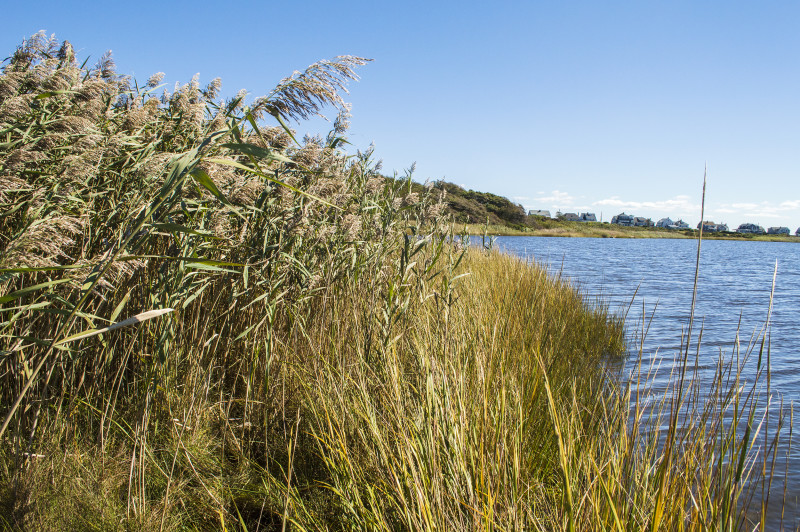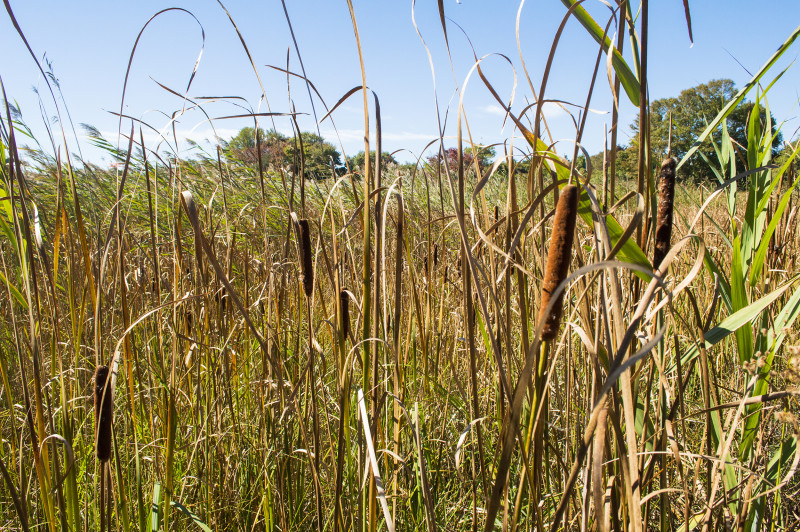Coalition works to wipe out invasive Phragmites from ponds in Dartmouth and Falmouth
At three salt ponds in Dartmouth and Falmouth, the Coalition is leading a project to restore wetlands infested with common reed (Phragmites australis), an invasive plant that is taking over salt marshes across Buzzards Bay.

Phragmites overtakes the native saltmeadow hay (Spartina patens) and threatens smooth cordgrass (Spartina alterniflora) along the edge of Salters Pond in Dartmouth.
Residents near Salters Pond in Dartmouth, Flume Pond in Falmouth, and Gunning Point Pond in Falmouth were grappling with a major problem: how to rid their marshes of Phragmites to protect and restore the ecology of the ponds.
In addition to providing picturesque places to enjoy the beauty of Buzzards Bay, the ponds attract a diverse array of wildlife species. Gulls, herons, and cormorants lounge on the water’s surface; along a sandy shore, monarchs flutter from flower to flower, enjoying the late summer goldenrod blooms. Earlier in the season, terns and other shorebirds feed here before migrating south for the winter.
Phragmites is another familiar – but unwelcome – species at the ponds. The Phragmites that grows here is invasive, meaning it’s not native to our region and harms the marsh ecosystem where it grows. At Salters Pond, Flume Pond, and Gunning Point Pond, Phragmites has overtaken much of the marsh habitat fringing the shore. Across acres and acres of once-diverse marshes, nothing but Phragmites exists today.
A Phragmites-infested marsh is a bit like a corn field: it grows so thickly and uniformly, no other plants can compete. But unlike corn, Phragmites stalks are all connected by underground rhizomes. So removing one plant won’t solve the problem – you have to get at the root of the issue.
Salters Pond, Flume Pond, and Gunning Point Pond are ideal locations to eradicate Phragmites because they are enclosed systems without any adjoining salt marshes. So there is a low chance that Phragmites will spread from a neighboring area and reinfest the marsh once the restoration project is complete.

Native cattails grow in the marsh at Salters Pond. A thick stand of Phragmites grows behind them, threatening to take over.
To conduct the work, the Coalition has hired an experienced contractor that specializes in managing invasive species. Eradicating Phragmites is a three-year process, using a combination of herbicides and mowing that has been proven effective in similar restoration projects.
During the first year, contractors apply an herbicide in late summer/early fall that is specifically designed for wetland plants; several weeks later, they will mow down the treated plant. During the second and third years, the contractors will apply smaller follow-up treatments. This work is expected to eliminate 99 percent of Phragmites at the ponds.
To ensure Phragmites doesn’t return, Coalition restoration staff will monitor for signs of the plant and remove any new growth they find. Over time, native species like cattails and smooth cordgrass will fill in where Phragmites once dominated, restoring the marshes to their natural diversity.